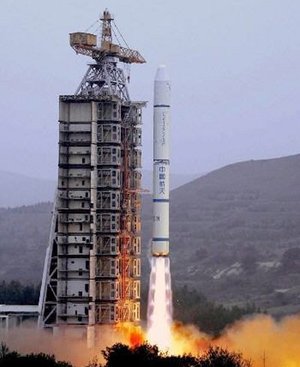Double Star overview

Name: Double Star
Launched: December 2003 and July 2004
Status: Completed (2007)
Objective
Double Star was a joint ESA/Chinese project to study the effects of the Sun on Earth's environment, and in particular the 'magnetotail', where storms of high-energy particles are generated.
Mission
Double Star followed in the footsteps of ESA's ground-breaking Cluster mission by studying the effects of the Sun on Earth's environment. It explored Earth's magnetosphere - the magnetic 'bubble' that surrounds our planet.
As its name suggests, Double Star involved two satellites - each designed, developed, launched and operated by the China National Space Administration - flying in complementary orbits around the Earth. One of the Double Star spacecraft flew in a polar orbit and the other close to Earth's equator.
This orbital configuration enabled scientists to obtain simultaneous data on the changing magnetic field and population of electrified particles in different regions of the magnetosphere.
The duo were launched from two different launch sites in China in December 2003 and July 2004. This schedule enabled them to operate alongside ESA's Cluster mission - a mini flotilla of four identical spacecraft launched into elliptical orbits around Earth.
The Double Star mission officially ended on 14 October 2007 when satellite TC-1 was decommissioned, burning up as it reentered Earth's atmosphere.
What’s special?
Conducting joint studies with Cluster and Double Star increased the overall scientific return from both missions.
A key aspect of ESA's participation in the Double Star project was the inclusion of seven instruments that were identical to those flying on the four Cluster spacecraft. One additional European instrument was an imager that monitored energetic neutral atoms (ENAs) in Earth's magnetosphere. A further eight experiments were provided by Chinese institutes.
By flying experiments identical to those on Cluster, the costs and development time were reduced.
Spacecraft

The equatorial spacecraft (TC-1) was launched at 20:06 CET, 29 December 2003, into an elliptical orbit of 550 kilometres by 66 970 kilometres, inclined at 28.5 degrees to the equator. This enabled it to investigate Earth's huge 'magnetotail', the region where particles are accelerated towards the planet's magnetic poles by a process known as 'reconnection'.
The polar satellite (TC-2) was launched at 15:15 CET, 25 July 2004. This concentrated on physical processes taking place over the magnetic poles and the development of aurorae. It had a 700 kilometre by 39 000 kilometre orbit taking it round Earth once every 11.7 hours.
History
The collaboration between the National Commission of Science and Technology of the People's Republic of China and ESA started in 1980 when the first agreement to exchange scientific and technical information on space programme and projects of mutual interest was signed.
Then in 1992, the Chinese Academy of Science signed an agreement with ESA to collaborate on the Cluster mission. Since then several Chinese scientists were hosted in Europe at ESA establishments and in European institutes and became co-investigators
In September 1999, the ESA Director-General was invited by the Administrator of the China National Space Administration (CNSA) to discuss the collaboration on the Double Star programme. In May 2001, ESA approved funding for collaboration and recommended the co-operation with China.
Finally in July 2001, ESA and CNSA signed the agreement on the Double Star programme, the first time that it was decided to put ESA experiments on board Chinese satellites.
Partnerships
Double Star was developed by the China National Space Administration.
ESA agreed to contribute 8 million euros to the Double Star programme. This funding was used for refurbishment and pre-integration of the European instruments, acquisition of data for four hours per day and co-ordination of scientific operations.







